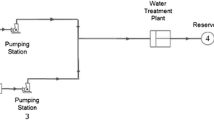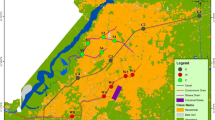Abstract
This paper presents the study of the occurrence of ten endocrine-disrupting compounds in twenty wastewater samples, collected from different sampling points throughout a wastewater treatment plant process. This work was assessed using ultra-performance liquid chromatography with electrospray ionization-tandem mass spectrometry that provides simultaneous quantification and confirmation of the presence of these emerging compounds. All samples were previously cleaned with vacuum filtration and extracted by solid-phase extraction. The compounds studied in this work are 17β-estradiol, ethinylestradiol, estriol, estrone, progesterone, mestranol and diethylstilbestrol, 4-n-nonylphenol, 4-tert-octylphenol and bisphenol A. The analytical limits were calculated for each compound and were used to identify and these target compounds in a wastewater treatment plant. The main conclusions obtained during this study emphasized that wastewater is an important contamination source of these compounds, the most common being bisphenol A and nonylphenol and wastewater treatment plants are not structured to remove endocrine-disrupting compounds. However some removal efficiencies were achieved for estriol (around 98 %) and bisphenol A (around 67 %) along treatment process, indicating that with some preventive approaches it is possible to minimize this problem.




Similar content being viewed by others
References
Barber, L. B., Loyo-Rosales, J. E., Rice, C. P., Minarik, T. A., & Oskouie, A. K. (2015). Endocrine disrupting alkylphenolic chemicals and other contaminants in wastewater treatment plant effluents, urban streams, and fish in the Great Lakes and Upper Mississippi River Regions. The Science of the Total Environment, 51, 195–206. doi:10.1016/j.scitotenv.2015.02.035.
Barreiros, L., Queiroz, J. F., Magalhães, L. M., Silva, A. M. T., & Segundo, M. A. (2016). Analysis of 17-β-estradiol and 17-a-ethinylestradiol in biological and environmental matrices—a review. Microchemical Journal, 126, 243–262. doi:10.1016/j.microc.2015.12.003.
Belhaj, D., Baccar, R., Jaabin, I., Bouzid, J., Kallel, M., Ayadi, H., & Zhou, J. L. (2015). Fate of selected estrogenic hormones in an urban sewage treatment plant in Tunisia (North Africa). The Science of the Total Environment, 505, 154–160. doi:10.1016/j.scitotenv.2014.10.018.
Boles, T. H., & Wells, M. J. M. (2010). Analysis of amphetamine and methamphetamine as emerging pollutants in wastewater and wastewater-impacted streams. Journal of Chromatography. A, 1217, 2561–2568. doi:10.1016/j.chroma.2010.01.014.
Carvalho, A. R. M., Cardoso, V. V., Rodrigues, A., Ferreira, E., Benoliel, M. J., & Duarte, E. A. (2015). Occurrence and analysis of endocrine-disrupting compounds in a water supply system. Environmental Monitoring and Assessment, 187, 139. doi:10.1007/s10661-015-4374-0.
Cesarino, I., Cincotto, F. H., & Machado, S. A. S. (2015). A synergistic combination of reduced graphene oxide and antimony nanoparticles for estriol hormone detection. Sensors and Actuators B: Chemical, 210, 453–459. doi:10.1016/j.snb.2015.01.013.
Chang, H. S., Choo, K. H., Lee, B., & Choi, S. J. (2009). The methods of identification, analysis, and removal of endocrine disrupting compounds (EDCs) in water. Journal of Hazardous Materials, 172, 1–12. doi:10.1016/j.jhazmat.2009.06.135.
Diniz, M. S., Mauricio, R., Petrovic, M., De Alda, M. J. L., Amaral, L., Peres, I., Barceló, D., & Santana, F. (2010). Assessing the estrogenic potency in a Portuguese wastewater treatment plant using an integrated approach. Journal of Environmental Sciences, 22(10), 1613–1622. doi:10.1016/S1001-0742(09)60297-7.
Directive 2013/39/EU of the European Parliament and of the Council of 12 August 2013 amending Directives 2006/60/EC and 2008/105/EC as regards priority substances in the field of water policy. (2013) Official Journal of the European Union L 226: 1–17. http://eur-lex.europa.eu/legal-content/EN/ALL/?uri=CELEX:32013L0039
Fredj, S. B., Nobbs, J., Tizaoui, C., & Monser, L. (2015). Removal of estrone (E1). 17β-estradiol (E2), and 17α-ethinylestradiol (EE2) from wastewater by liquid-liquid extraction. Chemical Engineering Journal, 262, 417–426. doi:10.1016/j.cej.2014.10.007.
Gaulke, L. S., Strand, S. E., Kalhorn, T. F., & Stensel, H. D. (2008). 17α-ethinylestradiol transformation via abiotic nitration in the presence of ammonia oxidizing bacteria. Environmental Science and Technology, 42(20), 7622–7627. doi:10.1021/es801503u.
He, X., Mei, X., Wang, J., Lian, Z., Tan, L., & Wu, W. (2016). Determination of diethylstilbestrol in seawater by molecularly imprinted solid-phase extraction coupled with high performance liquid chromatography. Marine Pollution Bulletin, 102, 142–147. doi:10.1016/j.mar.polbul.2015.11.041.
Henriques, M., Cardoso, V. V., Rodrigues, A. M., Ferreira, E., Benoliel, M. J., & Almeida, C. M. M. (2010). Simultaneous determination of ten endocrine hormone disrupters in water using SPE/LC-(ESI)MS-MS. Journal of Water Resource and Protection, 2, 818–829. doi:10.4236/jwarp.
Igunnu, A., Seok, Y., Olatunji, L., Kang, S., & Kim, I. (2015). Combined oral contraceptive synergistically activates mineralocorticoid receptor through histone code modifications. European Journal of Pharmacology, 769, 48–54. doi:10.1016/j.ejphar.2015.10.035.
Janicki, T., Krupiński, M., & Długoński, J. (2016). Degradation and toxicity reduction of the endocrine disruptors nonylphenol, 4-tert-octylphenol and 4-cumylphenol by the non-ligninolytic fungus Umbelopsis isabellina. Bioresource Technology, 200, 223–229. doi:10.1016/j.biortech.2015.10.034.
Kumar, V., Chakraborty, A., Viswanath, G., & Roy, P. (2008). Androgenic endocrine disruptors in wastewater treatment plant effluents in India: their influence on reproductive processes and systemic toxicity in male rats. Toxicology and Applied Pharmacology, 226, 60–73. doi:10.1016/j.taap.2007.08.023.
Li, H., Song, Y., & Peng, X. (2008). Improved synthesis of mestranol and ethinylestradiol (EE) related degradation products as authentic references. Steroids, 73, 488–494. doi:10.1016/j.steroids.2007.12.024.
Lian, J., Liu, J. X., & Wei, Y. S. (2009). Fate of nonylphenol polyethoxylates and their metabolites in four Beijing wastewater treatment plants. The Science of the Total Environment, 407, 4261–4268. doi:10.1016/j.scitotenv.2009.03.022.
Manickum, T., & John, W. (2014). Occurrence, fate and environmental risk assessment of endocrine disrupting compounds at the wastewater treatment works in Pietermaritzburg (South Africa). The Science of the Total Environment, 468–469, 584–597. doi:10.1016/j.scitotenv.2013.08.041.
Moraes, F. C., Rossi, B., Donati, M. C., Kleber, T. O., & Pereira, E. C. (2015). Sensitive determination of 17-β-estradiol in river water using a graphene based electrochemical sensor. Analytica Chimica Acta, 881, 37–43. doi:10.1016/j.aca.2015.04.043.
Pauwels, B., Noppe, H., De Brabander, H., & Verstraete, W. (2008). Comparison of steroid hormone concentrations in domestic and hospital wastewater treatment plants. Journal of Environmental Engineering, 134, 933–936. doi:10.1061/(ASCE)0733-9372(2008)134:11(933).
Pessoa, G. P., de Souza, N. C., Vidal, C. B., Alves, J. A. C., Firmino, P. I., Nascimento, R. F., & Santos, A. B. (2014). Occurrence and removal of estrogens in Brazilian wastewater treatment plants. The Science of the Total Environment, 490, 288–295. doi:10.1016/j.scitotenv.2014.05.008.
Qiang, Z., Dong, H., Zhu, B., Qu, J., & Nie, Y. (2013). A comparison of various rural wastewater treatment processes for the removal of endocrine-disrupting chemicals (EDCs). Chemosphere, 92, 986–992. doi:10.1016/j.chemosphere.2013.03.019.
Ryu, J., Yoon, Y., & Oh, J. (2011). Occurrence of endocrine disrupting compounds and pharmaceuticals in 11 WWTPS in Seoul, Korea. KSCE Journal of Civil Engineering, 15, 57–64. doi:10.1007/s12205-011-0913-6.
Sarkar, S., Ali, S., Rehmann, L., Nakhla, G., & Ray, M. B. (2014). Degradation of estrone in water and wastewater by various advanced oxidation processes. Journal of Hazardous Materials, 278, 16–24. doi:10.1016/j.hazmat.2014.05.078.
Spark, M., & Willis, J. (2012). Systematic review of progesterone use by midlife and menopausal women. Maturitas, 72, 192–202. doi:10.1016/j.maturitas.2012.03.015.
Spina, F., Cordero, C., Sciliro, T., Sgorbini, B., Pignata, C., Gilli, G., Bicchi, C., & Varese, G. C. (2015). Removal of micropollutants by fungal laccases in model solution and municipal wastewater: evaluation of estrogenic activity and ecotoxicity. Journal of Cleaner Production, 100, 185–194. doi:10.1016/jclepro.2015.03.047.
Staniszewska, M., Graca, B., & Nehring, I. (2016). The fate of bisphenol A, 4-tert-octylphenol and 4-nonylphenol leached from plastic debris into marine water—experimental studies on biodegradation and sorption on suspended particulate matter and nano-TiO2. Chemosphere, 145, 535–542. doi:10.1016/j.chemosphere.2015.11.081.
Stasinakis, A. S., Gatidou, G., Mamais, D., Thomaidis, N. S., & Lekkas, T. D. (2008). Occurrence and fate of endocrine disruptors in Greek sewage treatment plants. Water Research, 42, 1796–1804. doi:10.1016/j.watres.2007.11.003.
Tran, B. C., Teil, M. J., Blanchard, M., Alliot, F., & Chevreuil, M. (2015). BPA and phthalate fate in a sewage network and in an elementary river of France. Influence of hydroclimatic conditions. Chemosphere, 119, 43–51. doi:10.1016/j.chemosphere.2014.04.036.
Uhrovčík, J. (2014). Strategy for determination of LOD and LOQ values—some basic aspects. Talanta, 119, 178–180. doi:10.1016/j.talanta.2013.10.061.
Vandenberg, L. N., Luthi, D., & Quinerly, D. (2015). Plastic bodies in a plastic world: multi-disciplinary approaches to study endocrine disrupting chemicals. Journal of Cleaner Production. doi:10.1016/j.clepro.2015.01.071.
Xia, K.; Keller, H. L.; Bhandari; Wagner, J. (2011) Occurrence, distribution and fate of 4-nonylphenol in Kansas domestic wastewater treatment plants. Journal of Contemporary Water Research and Education 120: 5. http://opensiuc.lib.siu.edu/cgi/viewcontent.cgi?article=1156&context=jcwre. Accessed 12 November 2015
Author information
Authors and Affiliations
Corresponding author
Rights and permissions
About this article
Cite this article
Carvalho, A.R., Cardoso, V., Rodrigues, A. et al. Fate and Analysis of Endocrine-Disrupting Compounds in a Wastewater Treatment Plant in Portugal. Water Air Soil Pollut 227, 202 (2016). https://doi.org/10.1007/s11270-016-2910-3
Received:
Accepted:
Published:
DOI: https://doi.org/10.1007/s11270-016-2910-3




